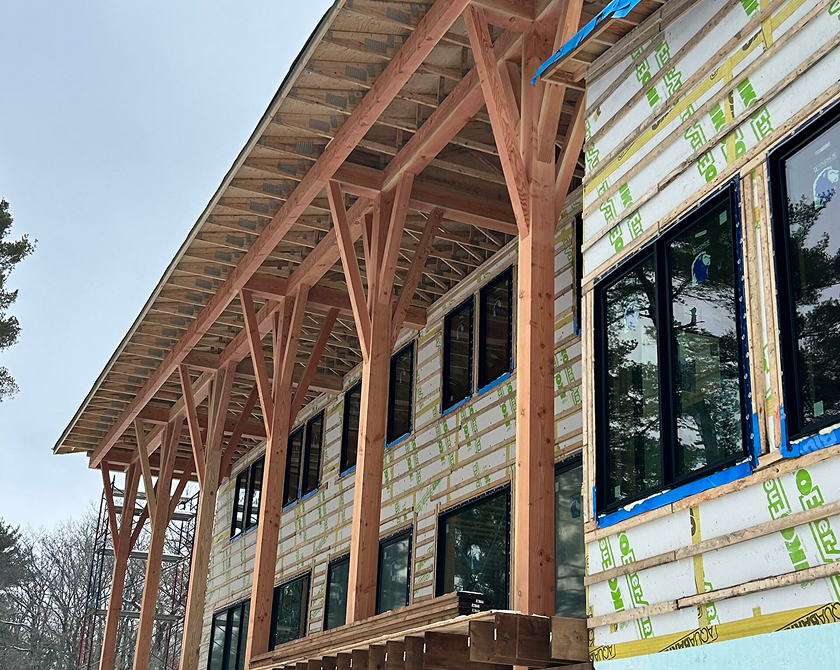The construction industry is experiencing a revolution fuelled by new materials that promise to reshape the way buildings are designed, constructed, and maintained. As demand grows for more sustainable, cost-effective, and durable structures, architects, engineers, and builders are turning to innovative materials that offer unique properties and capabilities. From self-healing concrete to carbon-neutral timber, these cutting-edge materials are setting the stage for a new era in construction.

In this blog post, we’ll explore some of the most exciting materials that are shaping the future of the construction industry and how they are changing the landscape of modern building practices.
1. Self-Healing Concrete
Concrete has long been the backbone of modern construction, but one of its most significant drawbacks is its susceptibility to cracking over time. Cracks in concrete can lead to structural damage, increased maintenance costs, and shorter building lifespans. Enter self-healing concrete, a groundbreaking material that can repair its own cracks and extend the life of concrete structures.
2. Carbon-Neutral Timber
Timber has been used in construction for centuries, but growing environmental concerns have led to a push toward using more sustainable and carbon-friendly materials. One of the most exciting developments in this area is carbon-neutral timber, which is produced in a way that reduces or eliminates its carbon footprint.
Through processes such as cross-laminated timber (CLT), which involves bonding layers of wood together to form strong, durable panels, this material has become a popular alternative to traditional steel and concrete for mid-rise and high-rise construction. CLT not only has a lower carbon footprint compared to concrete and steel, but it also stores carbon dioxide within the wood fibres, effectively reducing the amount of CO2 in the atmosphere. Additionally, timber’s natural properties, such as its insulating capabilities, can help improve energy efficiency in buildings.
3. Transparent Aluminum
The search for durable, lightweight, and transparent materials has led to the development of transparent aluminum, which combines the strength of metal with the transparency of glass. Often referred to as “aluminum oxynitride” (ALON), this material has incredible durability and resistance to scratching, making it ideal for applications that require both transparency and toughness.
4. 3D-Printed Concrete
The advent of 3D printing has disrupted multiple industries, and construction is no exception. With 3D-printed concrete, builders can create custom, complex structures with unparalleled precision and speed. This technique uses large-scale 3D printers to extrude layers of concrete that harden as they are laid down, allowing for the creation of intricate and even organic shapes that would be difficult or impossible to achieve with traditional construction methods.
3D printing in construction can significantly reduce material waste, increase design flexibility, and shorten project timelines. It has the potential to revolutionize the construction of buildings, bridges, and even entire neighbourhoods. In addition, it can be used to build affordable housing in less time and with fewer resources, which could help address housing shortages in urban areas.
5. Graphene
Graphene, a single layer of carbon atoms arranged in a two-dimensional lattice, is one of the most exciting materials in science today. This incredibly strong, lightweight, and conductive material is being explored for a wide range of applications, including construction. Graphene’s exceptional strength-to-weight ratio makes it an ideal material for reinforcing concrete and steel, improving the durability and safety of buildings.
In construction, graphene can be used to create stronger, lighter, and more energy-efficient materials. For example, graphene-infused concrete could be used to create buildings that are more resistant to cracking and damage, reducing maintenance needs. Additionally, graphene’s conductive properties can be used to develop smart materials that are capable of regulating temperature, storing energy, or even self-sensing structural issues.
As graphene production becomes more scalable and cost-effective, its application in the construction industry could have a transformative impact, making buildings not only stronger but also smarter and more sustainable.
6. Hempcrete
Hempcrete, made from hemp fibres, lime, and water, is gaining popularity as a sustainable alternative to concrete due to its low environmental impact and impressive insulation properties. It offers excellent thermal and acoustic insulation. Unlike traditional concrete, which is energy-intensive to produce and has a high carbon footprint, hempcrete is carbon-negative, meaning it absorbs more carbon dioxide than is emitted during its production.
In addition to its eco-friendly benefits, hempcrete is lightweight, breathable, and fire-resistant, making it ideal for building walls in residential and commercial properties. Its insulating properties can help reduce energy costs by keeping buildings warmer in winter and cooler in summer. As the demand for green building materials rises, hempcrete has the potential to become a go-to solution for eco-conscious builders.
7. Aerogel Insulation
When it comes to insulation, aerogel is one of the most advanced materials available. Often referred to as “frozen smoke,” aerogel is a highly porous, ultra-lightweight material that provides superior thermal insulation. Despite its lightness, aerogel is incredibly effective at preventing heat transfer, making it one of the best materials for energy-efficient building construction.
Aerogel can improve insulation, reduce energy consumption, and increase comfort in commercial and residential buildings. Its versatility allows it to be incorporated into walls, windows, roofs, and floors, providing an efficient and environmentally friendly solution for improving building performance.
8. Smart Glass
In the world of energy-efficient construction, smart glass is revolutionizing how windows are used. Smart glass can adjust its transparency in response to environmental conditions, such as temperature or sunlight, helping to regulate indoor temperatures and reduce the need for heating and cooling. This type of glass can change from clear to opaque or from light to dark with the flick of a switch or the use of a smartphone app.
Incorporating smart glass into a building’s design can improve both comfort and energy efficiency, reducing reliance on HVAC systems and lowering energy costs. Additionally, smart glass can provide privacy without sacrificing natural light, making it ideal for office buildings, residential homes, and even vehicles.
As the construction industry continues to evolve, these innovative materials are opening new possibilities for building smarter, more sustainable, and more durable structures. Whether it’s through the use of self-healing concrete, sustainable timber, or cutting-edge technologies like 3D printing and graphene, these materials are not only making construction more efficient but also helping to address global challenges like climate change, energy consumption, and resource depletion.








